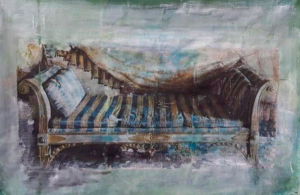CULTURE Italy-Israel, an Exhibit to Examine Today’s Painting
The distance between the reasons. This is the title of the double solo exhibit curated by Giorgia Calò, which puts the researchers of the Israeli painter Khen Shish (Safed 1970) and the Italian painter Veronica Botticelli (Rome 1979) near each other. The exhibition will be at Anna Marra Contemporanea gallery until October 21. A new artistic link between the two Countries; a front on which the curator has been working assiduously for a long time. The exhibit was born from the desire to investigate some aspects of today’s painting.
Calò, who is also alderwoman for Culture of Rome Jewish Community, says that both artists work on large formats and draw on paper as a complement to their researches. While Shish pays great attention to German expressionism and transavanguardia (she lived in Berlin and Rome for some years), as well as the Israeli painting old generation’s standards, Botticelli is nearer to a totally Italian tradition, precisely a Roman tradition, from Piazza del Popolo school to San Lorenzo school. However, both rely on the secret places of remembrance to make their subconscious emerge and expressing it through little details in their canvases.
Khen Shish painting is also “carnal, it’s based on order and disorder where colours and violent marks, figurative and non-figurative pictures, shape and abstraction interchange with one another”. The artist hates frames and everything that could contain, outline and put precise limits to her overflowing painting. In this way, pure fantasy works seem like an escape from reality. “Sometimes they lead us to fantastic places, some others they seem some nightmare’s set”.
Veronica Botticelli’s iconography instead, is determined by a single multifaceted theme with many meanings. It’s about the famous Singers, “those ones our mums and grandmas used for sewing”. They are the very symbol for a certain womanliness, perhaps lost, and for the manual skill, which suggests the creative act. The artist seems to suspend the picture, making it appear from a colour structured background where some papers are applied and become one with the canvas. “Veronica – Calò says – has chosen this object for its very poetic charge, raising it to the role of guardian of personal and shared remembrance, and here comes the nostalgic thought that we are staring at an art work which reminds us of a lost time”.
The exhibition is sponsored by the Israeli Embassy in Italy – Cultural Office and the Italy-Israel Foundation for Culture and the Arts.
Translation made by Rachele Ferin, student at the Advanced School for Interpreters and Translators of Trieste University, intern at the newspaper office of the Union of the Italian Jewish Communities.

